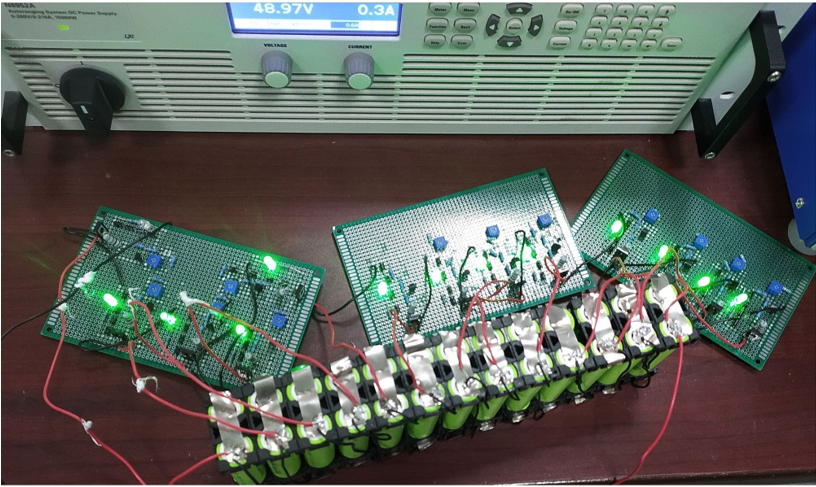Development of Passive Battery Management System at TRL 4
Abstract
Nowadays, the usage of the electric vehicle (EV) is exponentially increasing. Therefore, a battery management system (BMS) is required to properly operate the Li-ion battery used in electric vehicles for extending the battery life. The main function of BMS is to sense the voltage, current, and temperature of the battery and cells independently. Further, it evaluates different parameters from the data fetched by the BMS. Finally, based on the evaluation, it controls the cell balancing. Presently, BMS is implemented using different microcontrollers and is under improvement with the advancement in existing technology. Passive balancing is commonly used in BMS, since, it is inexpensive and straightforward to implement. The passive resistor uses the passive balancing method to discharge the battery’s excess charge. For small battery capacities, this resistor is very useful. This paper analyses BMS design which combines a power resistor and transistor as a balancing resistor. The proposed analyses were applied to a battery pack consisting of 13 lithium-ion battery cells which enabled a fast-charging scheme. The most significant features of the passive balancing system are based on the results of this experiment, taking into account the impact on battery performance and energy loss. The aim of this paper is to make a battery pack that is with high energy carrying capability and proper thermal runaway. Thus, extensive monitoring is needed to operate the battery within specified operating limits to avoid fire hazards and explosions. In order to achieve this, the proposed design creates a demand for a Sophisticated management system which not only optimize the power drawn from battery but also maintain the battery operation within specified limits.
References
Dhingra, Karanveer, and Mukesh Singh. "Frequency support in a micro‐grid using virtual synchronous generator based charging station." IET Renewable Power Generation 12, no. 9 (2018): 1034-1044.
Hannan, Mahammad A., Md Murshadul Hoque, Aini Hussain, Yushaizad Yusof, and Pin Jern Ker. "State-of-the-art and energy management system of lithium-ion batteries in electric vehicle applications: Issues and recommendations." IEEEE Access 6 (2018): 19362-19378. DOI: 10.1109/ACCESS.2018.2817655
Affanni, Antonio, Alberto Bellini, Giovanni Franceschini, Paolo Guglielmi, and Carla Tassoni. "Battery choice and management for new-generation electric vehicles." IEEE Transactions on Industrial Electronics 52, no. 5 (2005): 1343-1349. DOI: 10.1109/TIE.2005.855664
Xu, Dongping, Lifang Wang, and Jian Yang. "Research on li-ion battery management system." In 2010 International Conference on Electrical and Control Engineering, pp. 4106-4109. IEEE, 2010. DOI: 10.1109/iCECE.2010.998
Brandl, M., Harald Gall, M. Wenger, V. Lorentz, Martin Giegerich, Federico Baronti, Gabriele Fantechi et al. "Batteries and battery management systems for electric vehicles." In 2012 Design, Automation & Test in Europe Conference & Exhibition (DATE), pp. 971-976. IEEE, 2012. DOI: 10.1109/DATE.2012.6176637
Otero, Noemi, Habiballah Rahimi-Eichi, Juan J. Rodriguez-Andina, and Mo-Yuen Chow. "FPGA implementation of an observer for state of charge estimation in lithium-polymer batteries." In 2014 International Conference on Mechatronics and Control (ICMC), pp. 1646-1651. IEEE, 2014. DOI: 10.1109/ICMC.2014.7231839
Hauser, A., and R. Kuhn. "Cell balancing, battery state estimation, and safety aspects of battery management systems for electric vehicles." In Advances in battery technologies for electric vehicles, pp. 283-326. Woodhead Publishing, 2015. DOI: 10.1016/B978-1-78242-377-5.00012-1
S.Wang, Y. Fan, D.-I. Stroe, C. Fernandez, C. Yu, W. Cao, Z. Chen, Battery state-of-charge estimation methods, in: S. Wang, Y. Fan, D.-I. Stroe, C. Fernandez, C. Yu, W. Cao, Z. Chen (Eds.), Battery System Modeling, Elsevier, 2021, pp. 157198
Madej, Wiesław, and Andrzej Wojciechowski. "Analysis of the Charging and Discharging Process of LiFePO4 Battery Pack." Energies 14, no. 13 (2021): 4055. DOI: 10.3390/en14134055
N. Kularatna, K. Gunawardane, Rechargeable battery technologies: An electronic circuit designer’s viewpoint, in: N. Kularatna, K. Gunawardane (Eds.), Energy Storage Devices for Renewable Energy-Based Systems (Second Edition), second edition Edition, Academic Press, Boston, 2021, pp. 6598.
Cabrera, José, Aurelio Vega, Félix Tobajas, Víctor Déniz, and Himar A. Fabelo. "Design of a reconfigurable Li-ion battery management system (BMS)." In 2014 XI Tecnologias Aplicadas a la Ensenanza de la Electronica (Technologies Applied to Electronics Teaching)(TAEE), pp. 1-6. IEEE, 2014. DOI: 10.1109/TAEE.2014.6900162
Hoffart, Fran. "Proper care extends Li-ion battery life." Power Electronics 25 (2008). http://www.arocholl.com/Datos/804PET22li-ion-battery-life.pdf
Kim, Chol-Ho, Moon-Young Kim, and Gun-Woo Moon. "A modularized charge equalizer using a battery monitoring IC for series-connected Li-ion battery strings in electric vehicles." IEEE Transactions on Power Electronics 28, no. 8 (2012): 3779-3787. DOI: 10.1109/TPEL.2012.2227810
Manenti, Antonio, Andrea Abba, Alessandro Merati, Sergio M. Savaresi, and Angelo Geraci. "A new BMS architecture based on cell redundancy." IEEE Transactions on Industrial Electronics 58, no. 9 (2010): 4314-4322. DOI: 10.1109/TIE.2010.2095398
Liaw, Bor Yann, F. Wang, and Y. Wei. "Managing safety risk by cell manufacturers." Electrochemical Power Sources: Fundamentals, Systems, and Applications: Li-Battery Safety (2018): 1.

Copyright (c) 2022 Mukesh Singh, Rahul Kumar Kamboj (Author)

This work is licensed under a Creative Commons Attribution 4.0 International License.






